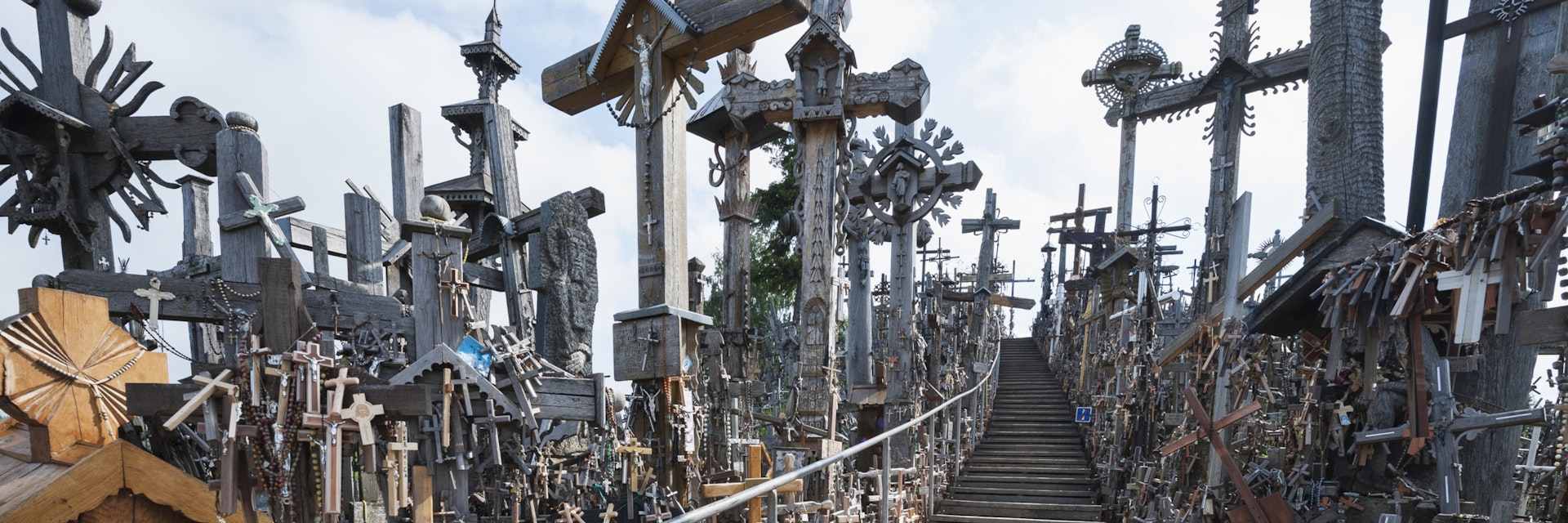Lithuania's fabled Hill of Crosses is a symbol of defiance as much as a pilgrimage site. More than 100,000 crosses have been planted on this low hill, many of them strung with rosary beads that rattle softly in the breeze. The tradition began during the 1831 Uprising and reached its height in the 1960s, in defiance of anti-religious Soviet rule. At night locals crept here to lay crosses, infuriating their oppressors. It's 12km north of Šiauliai (2km off Hwy A12) near Jurgaičiai.
Repeated efforts to bulldoze the hill during the 1960s and '70s didn't deter locals from placing crosses here, despite the harsh punishments for being caught. Today it is forbidden to remove a cross from the site, and any visitor may plant a cross (up to a certain size). Enterprising vendors sell simple wooden crucifixes near the visitor centre; they loan marker pens for devotees to write a family name, prayer or wish onto the cross before placing it in the soil.
Large and tiny, expensive and cheap, wood and metal, the crosses are devotional, to accompany prayers, or finely carved folk-art masterpieces. Others are memorials tagged with flowers, a photograph or other mementos of the deceased, and inscribed with a sweet or sacred message. Traditional Lithuanian koplytstulpis (wooden sculptures of a figure topped with a little roof) intersperse the crosses, as do magnificent sculptures of the Sorrowful Christ (Rūpintojėlis). If you wish to add your own, souvenir traders in the car park sell crosses big and small. Some of the crosses are devotional, others are memorials (many for people deported to Siberia). They vary greatly in size and some are accompanied by mournful statues of the Virgin Mary. The devout come from far and wide; you may spot a memorial to 9/11 victims and another to Ukrainians killed in ongoing Russia-Ukraine conflict.
A pathway leads from the hill to a modern chapel; it's worth looking inside to see a view of the Hill of Crosses perfectly framed in the large window at the altar.
Legends swirl around the Hill of Crosses. Some locals claim that the mound conceals the bodies of 14th-century warriors, others swear that it's haunted by monks. It's more than likely that the hill was a pre-Christian worship site.
An alternative view of the cross-swamped hill is from inside the chapel of the modern brick monastery. Now home to around a dozen Franciscan monks, it was built behind the hill from 1997 to 2000. The monastery was allegedly the idea of the late Pope John Paul II, who said after visiting the hill in 1993 he would like to see a place of prayer here. Behind the altar in the church, the striking backdrop seen through the ceiling-to-floor window of the Hill of Crosses is very moving; Italian architect Angelo Polesello designed it.
From the Hwy A12, it's another 2km east from a well-marked turn-off ('Kryžių kalnas 2'). From Šiauliai, take a Joniškis-bound bus (€1.50, 10 minutes, up to seven daily) to the 'Domantai' stop and walk for 20 minutes, or grab a taxi (around €20).
By bicycle, the Hill of Crosses makes for a gentle three-hour trip out and back, mostly along paved bicycle paths that lie to the side of the main road. The tourist office hires out bikes (€1.50 per hour) and can show the route (mostly straight along the main road in the direction of Rīga, turning right at the sign for the last 2km.

